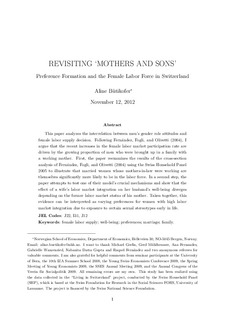| dc.contributor.author | Bütikofer, Aline | |
| dc.date.accessioned | 2015-02-25T07:28:37Z | |
| dc.date.accessioned | 2015-02-26T08:58:03Z | |
| dc.date.available | 2015-02-25T07:28:37Z | |
| dc.date.available | 2015-02-26T08:58:03Z | |
| dc.date.issued | 2013-01 | |
| dc.identifier.citation | Labour Economics 2013, 20:82-91 | nb_NO |
| dc.identifier.issn | 0927-5371 | |
| dc.identifier.uri | http://hdl.handle.net/11250/277773 | |
| dc.description | NOTICE: This is the author’s version of a work that was accepted for publication in "Labour Economics". Changes resulting from the publishing process, such as peer review, editing, corrections, structural formatting, and other quality control mechanisms may not be reflected in this document. Changes may have been made to this work since it was submitted for publication. A definitive version was subsequently published in "Labour Economics" 2013, 20:82-91,doi:10.1016/j.labeco.2012.11.003 . Copyright © 2011 Elsevier Ltd. All rights reserved | nb_NO |
| dc.description.abstract | This paper analyzes the interrelation between men's gender role attitudes and
female labor supply decision. Following Fernández, Fogli, and Olivetti (2004), I argue that the recent increases in the female labor market participation rate are
driven by the growing proportion of men who were brought up in a family with
a working mother. First, the paper reexamines the results of the cross-section
analysis of Fernández, Fogli, and Olivetti (2004) using the Swiss Household Panel
2005 to illustrate that married women whose mothers-in-law were working are
themselves significantly more likely to be in the labor force. In a second step, the
paper attempts to test one of their model's crucial mechanisms and show that the
effect of a wife's labor market integration on her husband's well-being diverges
depending on the former labor market status of his mother. Taken together, this
evidence can be interpreted as varying preferences for women with high labor
market integration due to exposure to certain sexual stereotypes early in life. | nb_NO |
| dc.language.iso | eng | nb_NO |
| dc.publisher | Elsevier Ltd. | nb_NO |
| dc.subject | female labor supply | nb_NO |
| dc.subject | well-being | nb_NO |
| dc.subject | preferences | nb_NO |
| dc.subject | marriage | nb_NO |
| dc.subject | family | nb_NO |
| dc.title | Revisiting 'mothers and sons' preference formation and the female labor force in Switzerland | nb_NO |
| dc.type | Journal article | nb_NO |
| dc.type | Peer reviewed | nb_NO |
| dc.date.updated | 2015-02-25T07:28:37Z | |
| dc.source.pagenumber | 82-91 | nb_NO |
| dc.source.volume | 20 | nb_NO |
| dc.source.journal | Labour Economics | nb_NO |
| dc.identifier.doi | 10.1016/j.labeco.2012.11.003 | |
| dc.identifier.cristin | 1030559 | |
